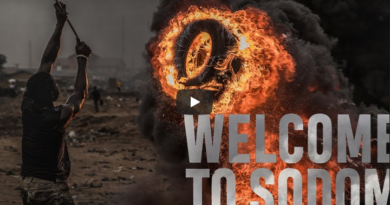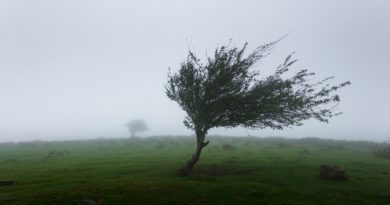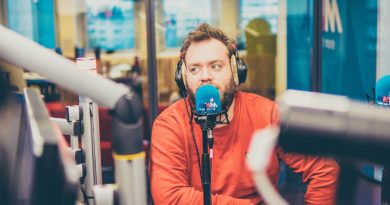Brussels Writers Series VIII – By a name I know not how to tell thee who I am
By a name I know not how to tell thee who I am – Romeo. Romeo & Juliet, Shakespeare
In New York City’s Central Park there is a statue of a dog. Balto, a Siberian Husky, became famous for leading a rescue mission through blizzards, bringing medicine from Alaska to Nome.
In Tokyo’s Shibuya station there is the statue of Hachikō, an Akita Uni dog who went to meet his owner at the station every evening, and continued to wait for him every day for nine years after the man had died.
In Brussels’ Park Cinquantenaire, or Jubelpark, there is a dog sculpture, too. It is called “The dog », and often referred to as “the green dog“. It was made by Jean-Baptiste Van Heffen and originally exhibited at the Royal Museum of Fine Arts, then placed in the park. While temporarily moved to the entrance of park Woluwe for an exhibition, it gave it’s name to a café there: Café-Laiterie du Chien vert. Some say the green has been added to the name because people rub the sculpture for good luck.
To me, Brussels is like this sculpture. It doesn’t incarnate one story, it inspires many. When walking up Montmartre in Paris, seeing Manhattan from a ferry or watching waves of people cross the street in Tokyo there is a moment of recognition ̶ it’s like I thought it would be from what I saw in the cinema. Where is this movie-moment in Brussels? The TV usually shows the European Parliament and the Commission. I can see the later from my window, behind a hilly roofscape of Art Nouveau houses.
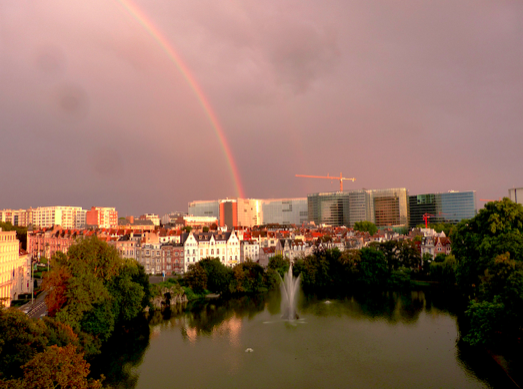
At night not only are the commissions’ windows are lit, but there are lights on the lake. Someone is canoeing around swimming candles. On New Year’s Eve, someone shoots rockets over the lake, delighting all the neighboring parties. In January, birds walk their shadows across the ice.
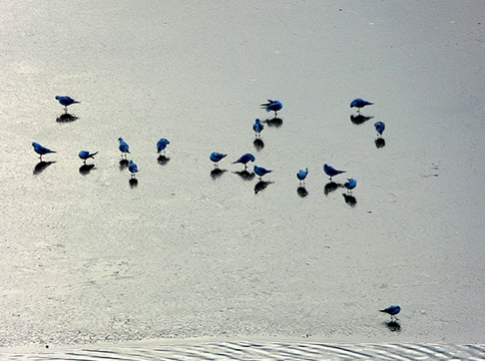
Let me add a quick note on the weather here. I don’t think it’s grey unless you think of grey as all the colors mixed together. Sunny in the morning, rain at lunchtime, thunder in the afternoon, clouds at dinnertime and clear sky at night. It’s April, always. And windy.
The park around the lake, populated by ducks, doves and parrots, kissing couples, caring grandparents, people practicing Tai Chi or peeing against a tree, is at its most beautiful in tulip season when the round flower beds bloom in red, yellow, pink, black, purple, and white. A series of ink drawings inspired by them was shown in my first exhibition here, held in one of the many artist-run spaces. The day after the opening I walked into a gallery in the center, inviting them to see it. On the last day of the show the gallery manager came in with his kid. He just happened to live next door.
Proximity plays a leading role here, people are approachable and distances walkable, places are near. When arriving in 2015 I got a job in an Irish pub I used to go to to write, swapping stories with the bartender. Michael Collins, in rue Bailli, is owned by the same people as De Valera at Place Flagey (now closed), the pubs named after two Irish men who hated each other are but a street away.
When Collins closes in the late night or early in the morning the staff sends people to Supra, one of the four restaurant/bars marking the crossroad in rue Bailli. It’s a place like a time machine, the twin towers on a poster behind the bar, old curtains and all kinds of characters.
At 9 or 10 a.m., there are people like me, writing, drawing, toying with ideas. There are tourists having croissants, regulars drinking a little glass of red, or beer, having coffee and cigarettes, talking. Coffee to go hasn’t really caught on here. Asking how someone came to live in Brussels often triggers answers like, « I came for this person/internship/event… twelve years ago. »
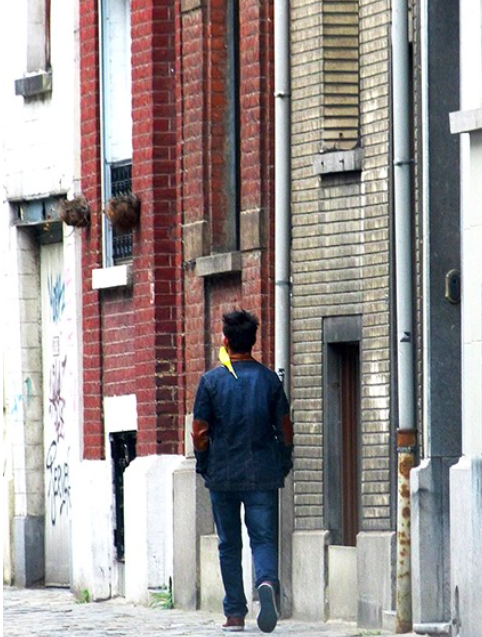
In the bus the next stop is announced as « Froissart – Froissart« . It’s written the same, and it sounds like the same and it is Flemish and French. As an artist this daily diversity freed something in me. I used to believe that I ought to choose a medium, maybe a language. Here the disparate inspires new forms. In a frameshop/gallery in rue Bailli I look at Christian Dotrement’s Logogrammes, which merged poetry with painting, making us see poetry. In a collaboration of Belgian-Maroccan choreographer Sidi Larbi Cherkaoui and artist Anthony Gormley shown at the Théâtre National clay forms a floor for dancers who then turn it into masks, into a camera, a cocktail, a penis.
Maybe there isn’t the movie moment in this city because it never settles into one coherent form, it’s image is never dominated by a single feature. Bureaucratic and disorganized, beautiful and dirty, grand and familiar, green and dense. If the soul of Brussels were a thing it’d be a kaleidoscope, or a moving stage.
My favorite Vietnamese restaurant is furnished by the upholstery of a German train. My yoga classes takes place in an old garage that has been turned into a dance Academy, and the writing desk I share with a clown is in a laundromat that became a creative co-working space.
The map of Brussels looks like paper under a microscope. The roads aren’t straight, it seems to have grown organically and it takes time to figure out which ways run kind of parallel. There are gardens between clusters of tall town houses. Looking out of back windows reveals not only green spots but all kinds of rooftops and balconies, hidden views. Windows aren’t on one level here and buildings are so diverse they seem natural in their assemblage of different styles.
Next to a big mosque in Park Cinquantenaire is the Pavilion of the Human Passions, designed by Victor Horta. It houses a monumental fresco by Jef Lambeaux showing, yeeees, the Human Passions. Downtown, a few streets from Grand Place, after a rainbow colored zebra crossing there is Mademoiselle, a cabaret presenting local and international artists. Although the decor is simple walking in after work feels like entering a theatre ̶ the atmosphere is extravagant and casual, exotic and familiar. Burlesque, boylesque, draglesque ̶ anything goes here, and that feels like Brussels to me. A stage is a stage is a stage and a city is a city is a city, until we attach a story to it. Brussels has many. It’s as we like it.
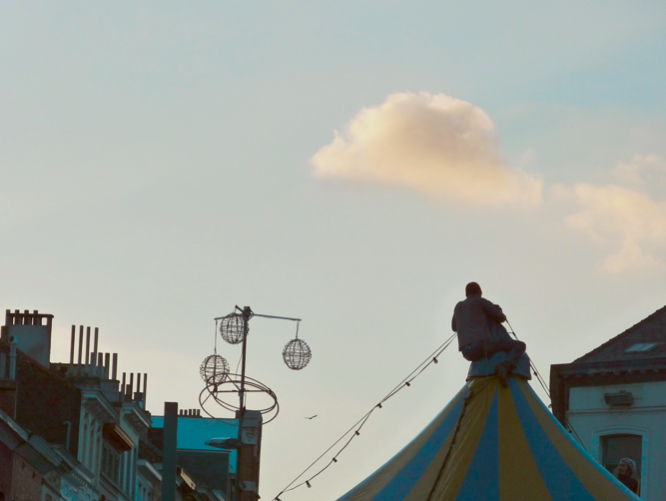
Good to know
An anthology by Brussels Writers – The Circle – will be launched on November 22nd at Waterstones in Brussels, and is also available online here.

